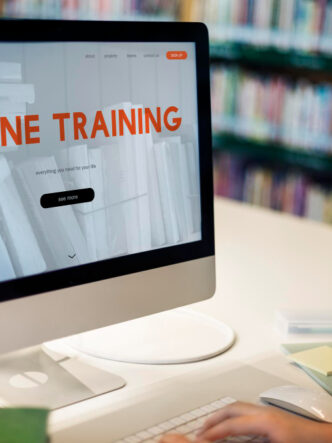The online education sector has undergone many changes over the past decade.

Since the start of the pandemic, online courses have been more popular than ever.
Leading online platforms such as Teachable and Thinkific make it easy for online course creators to build their courses and make money but they also have certain limitations, such as access to only basic video analytics and basic video solutions.
If you want to achieve online course success, you need your students to be fully engaged with the material you present.
One of the best ways to engage them is by using video. Since the popularization of online video, teachers and students have used it more and more as a learning resource in online teaching.
Analyzing video data makes it possible to personalize learning experiences for students. You don’t just want your online course videos to look great – you want them to offer the best results.
What is video analytics for online courses?
Video analytics provide a way to determine how students engage with your videos.
How do video analytics work? Analyzing raw data involves the use of video analytics software.
There are various techniques and tools that help with analyzing data from videos published on online courses.
The analysis of raw data from videos help you to draw certain conclusions and make better decisions based on information.
Following are the reasons why video courses are required by online course creators:
Benefits of online courses
Some of the main benefits of using videos for online courses include the fact that they appeal to different learning styles, are available round-the-clock and offer cost-efficiency.
They appeal to students who like to learn visually and through hearing and can enhance memory and cognition.
However, you can’t work in the dark when using videos for online courses. This is where collecting and analyzing data from video with video analytics software comes into play.
Video analytics for online courses
You can gain insights from video analytics data that can maximize the performance of your online course videos.
Analyzing video data is only valuable if it brings about meaningful change.
Do students watch only part of a video and then drop it off? If plenty of students drop off at a certain point of the video, you need to consider why they are doing so.
Perhaps the video is too long, in which case splitting the content into two separate videos may increase engagement.
Without this kind of information, you won’t understand how students interact with your videos or what you can do to improve them, and video analytics helps online course content creators to make those decisions easily.
Why do online courses need a robust video analytics hosting solution?

Online learning platforms like Teachable and Thinkific offer a great way to manage your online courses and some very basic customization is possible.
However, these online course platforms were not built specifically with videos in mind and they deal with many different types of content.
Collecting the right data and using data analysis tools can help to improve the user experience.
Students expect personalization on online courses
Advanced video analytics allows for more personalization on online courses, something which students expect today.
They all have different learning styles and when students have a say in how and when online learning takes place, they are more motivated to learn.
When students can learn at their own pace, they are more likely to retain information.
Students can watch a certain part of a video over and over until they understand it and skip over parts they already understand.
Robust video analytics offered by private video hosting platforms make it possible to address issues and make changes that help with learning.
You need to outperform online course competitors
Using robust video analytics can help online course creators to outperform their competitors.
The online education space has become very competitive and unless you have the type of insights that can offer you a competitive advantage, it can be difficult to find success.
When you can leverage the data you accumulate from video viewers, you have the key in your hand to perfecting your video performance. By gathering insights from videos, you can improve your online courses and make sure that students are fully engaged.
Students become more motivated to complete a course that benefits you because they are more likely to want to do any other courses you offer in the future.
With personalization from video analytics data, students are also more likely to recommend your online course to other people.
You can find trends and patterns on videos with video hosting
Video analytics may clue you into certain patterns – you may find that all your students listen to a certain segment of the same video over and over.
This could indicate that this particular segment is difficult to understand.
If data analysis of video analytics shows you certain trends or patterns like this, it gives you key insights on how to make changes.
When a particular video contains information that is too challenging, it could make students less motivated and simplifying certain content may be necessary for them to complete a course.
Know whether you are meeting your goals with video analytics
Unless you have access to data and analytics, you won’t know whether you’re achieving your goals.
For example, unless you can measure your number of users against your target users, you have no idea whether your course numbers are improving.
Collecting granular data about the number of students you attract from different locations can help you to identify trends and pick out possible future areas to target.
Access to data analytics helps you to develop the right strategies so you can expand your business and meet your goals.
5 of the best video analytics features for online courses

Video data analytic tools need certain features to fully meet user needs. Certain features of video analytics work very well in helping you to improve your online courses.
With analytics, actionable information regarding the learning process is made available and it is even possible to detect patterns that indicate problems or present opportunities.
1. API for video analytics
An application Programming Interface (API) is a key building block that enables data integration and visualization.
When video analytics are easily integrated with other platforms, the automatic transferring and encoding of data can take place.
The less time spent on customizing integrations to connect analytics systems to data sources, the more time can be spent on deploying and running analytics models.
Easy integration of platforms and access capabilities make it easier to share results with other users and improve results.
2. Granular Video Analytics per User
Granular video analytics are available for each user with video hosting platform.
A viewer’s screen contains all the information about a specific user, such as location, average engagement, viewing time, first and last view dates, IP address, and platform.
You can identify viewers, track them and send data to your CRM for smarter lead nurturing. By finding out how much time a user spends on each video, you can find out which ones appeal to them most.
Understanding the viewing history and viewing habits of users allows you to customize what videos you offer them.
If you know what devices your students use most, you can make sure you give them the best possible experience on these devices.
As an example, if the video analytics data shows most students are using mobile devices, online courses need to make sure video content appears correctly on them.
With adaptive bitrate streaming from video hosting solutions, bitrate streaming is designed to deliver video to each user in the most efficient way possible and at the highest usable quality.
Adaptive streaming allows the creation of a different video for each screen size or device you want to target.
3. Analytics per video
Analytics are available for each specific video so you can find out how your target audience reacts to each one.
For example, by A/B testing videos, you can identify whether students prefer animated videos or real-life ones. By putting two videos head to head, you can easily see which one is a winner.
If students keep jumping forward in a specific video, it could indicate that they find the information of little interest or redundant and it could be trimmed or cut out.
Another use of data from analytics showcases that if certain video segments are viewed frequently, they could be complemented by using annotations to increase retention and clicks from users.
4. Video Heatmaps
A video heatmap has a color-coded timeline that offers a second-by-second breakdown of how a student engages with a video.
Heatmaps shows in a graphic form where a viewer stops, pauses, rewinds, or fast-forwards. These insights can show which parts excite students the most and where you could make improvements.
A heatmap also contains viewer information and contextual information such as when and where a student watched a video.
With heatmaps, you can identify key points of interest and boring content so you can improve your videos.
5. Real-time video analytics
Real-time video analytics data helps you to understand how your live stream is performing as it happens and you can gauge the mood of the audience.
You can see the total number of viewers watching, the number of new viewers joining, a global picture of the location of viewers all over the world and more with a detailed viewing heatmap and engagement rate.
Online courses can also see additional information such as the device types people are using, names and email addresses.
Drawbacks of hosting videos on online course platforms – Teachable and Thinkific

Limited Video Encryption & Video Security
One of the major concerns of online course administrators is video security and video encryption.
If someone gains access to online course content without paying or tries to reuse video assets, this could affect the success of the course.
Protecting course content is a top priority and using industry-grade encryption is the first step towards this.
Other video security measures include multi-factor authentication for logging in, enabling Right Click Protection to prevent individuals from accessing video source code or using password protection.
Using domain lock means your videos can only appear on specific domains.
Various layers of video security are essential to prevent unauthorized viewers from accessing, viewing, downloading, embedding or sharing video course content.
Online course platforms often don’t have the advanced levels of video security that are offered by top video hosting platforms.
Online Course Platform don’t have video hosting capabilities
Hosting videos on online course platforms has various other limitations as they were designed to handle many different forms of material.
Many online courses today consist of more video content than any other form of content.
Customization, analytics, security and the viewing experience are all very important when it comes to managing the videos you use in your online courses.
Online course creators need extra features of video hosting solution to get the most out of their video courses.
Lack Video Enhancement tools
Online course platform consider video content as a secondary function for courses.
Content publishers on platforms like Thinkific & Teachable do not have the option of adding a customizable video player with branding, CTA’s, etc.
With Cincopa’s video solution, online course creators can add forms to their videos for lead generation, create brandable video player, add chapters to long videos & integrated their video web form with marketing automation platform like HubSpot.
Get video analytics software for your online course videos

If your online students do not have a seamless viewing experience, your online course will not be successful.
Using intelligent video analytics enables you to provide users with the best possible experience. To gather as much visibility as possible, using a data dashboard that offers the most up-to-date information is best.
A video hosting service provider like Cincopa offers the level of intelligent video analytics you require for your online course videos.
Navigate to an ‘Analytics’ area and you can see general information such as view count and viewer engagement percentage. If you select ‘see Heatmap,’ you can view in-depth data specific to a selected video.
A Cincopa dashboard offers aggregate video stats within a selected timeframe and data is presented in graphs that are easy to understand.
With Cincopa, online courses can change displayed time periods from weekly to monthly or to all-time. Content creators can also see details such as on which days you had more viewers than others.
There are many ways to enhance your online course videos on Cincopa. It is also easy to embed your videos directly from Cincopa into your e-learning courses on other platforms.
Cincopa uses SEO-friendly JSON-LD embed codes, which you can copy and paste on an e-learning website and the video will appear where you paste it.
Conclusion
When assessing the performance of an online course, you can’t just speculate that you’re ticking all the right boxes.
You need data to understand how students interact with your online course videos.
How long students watch a video? How frequently do they watch certain videos? What devices and browsers do they use?
Analyzing data from intelligent video analytics provides you with the actionable insights you need to customize your video content and make sure of the success of your online courses.










